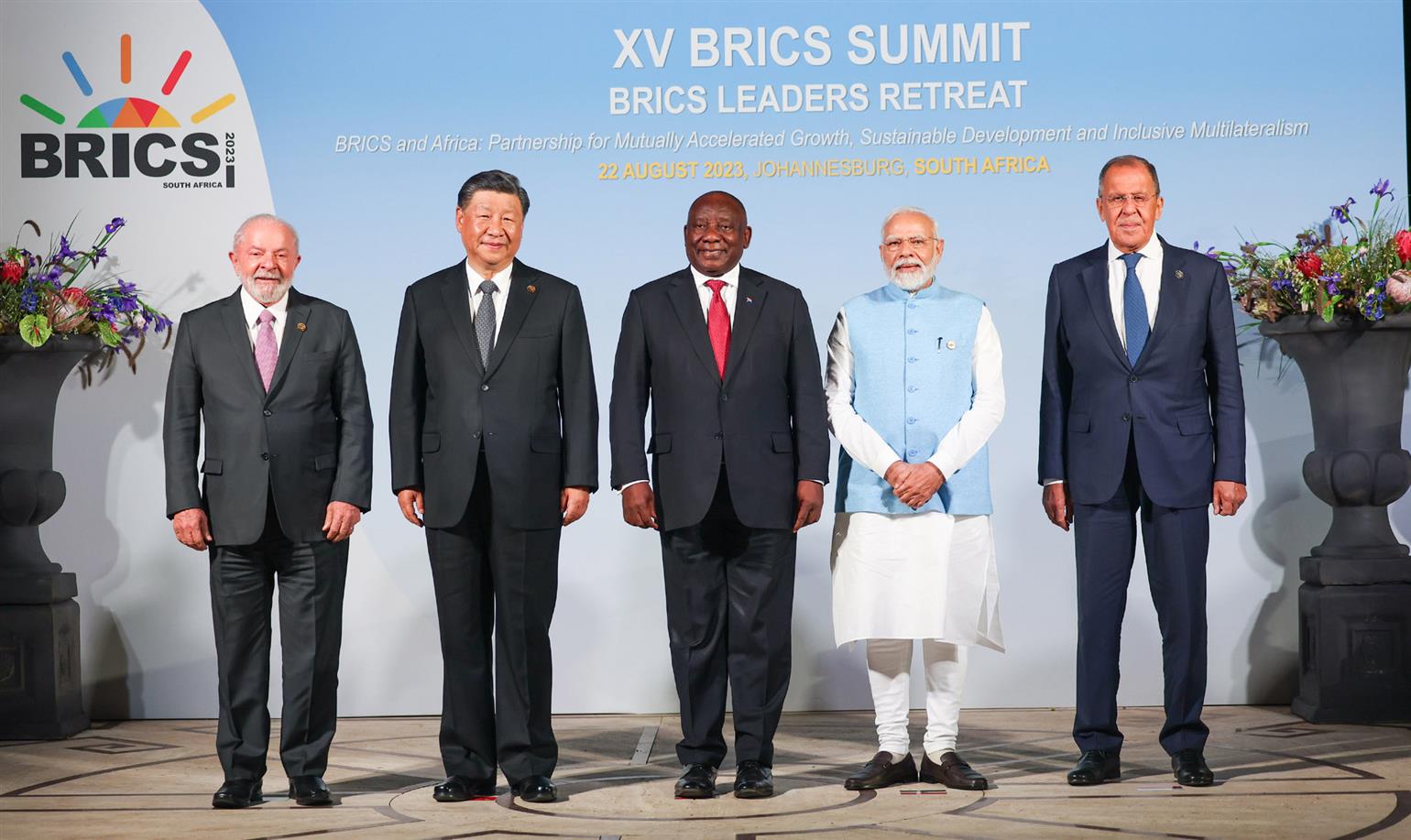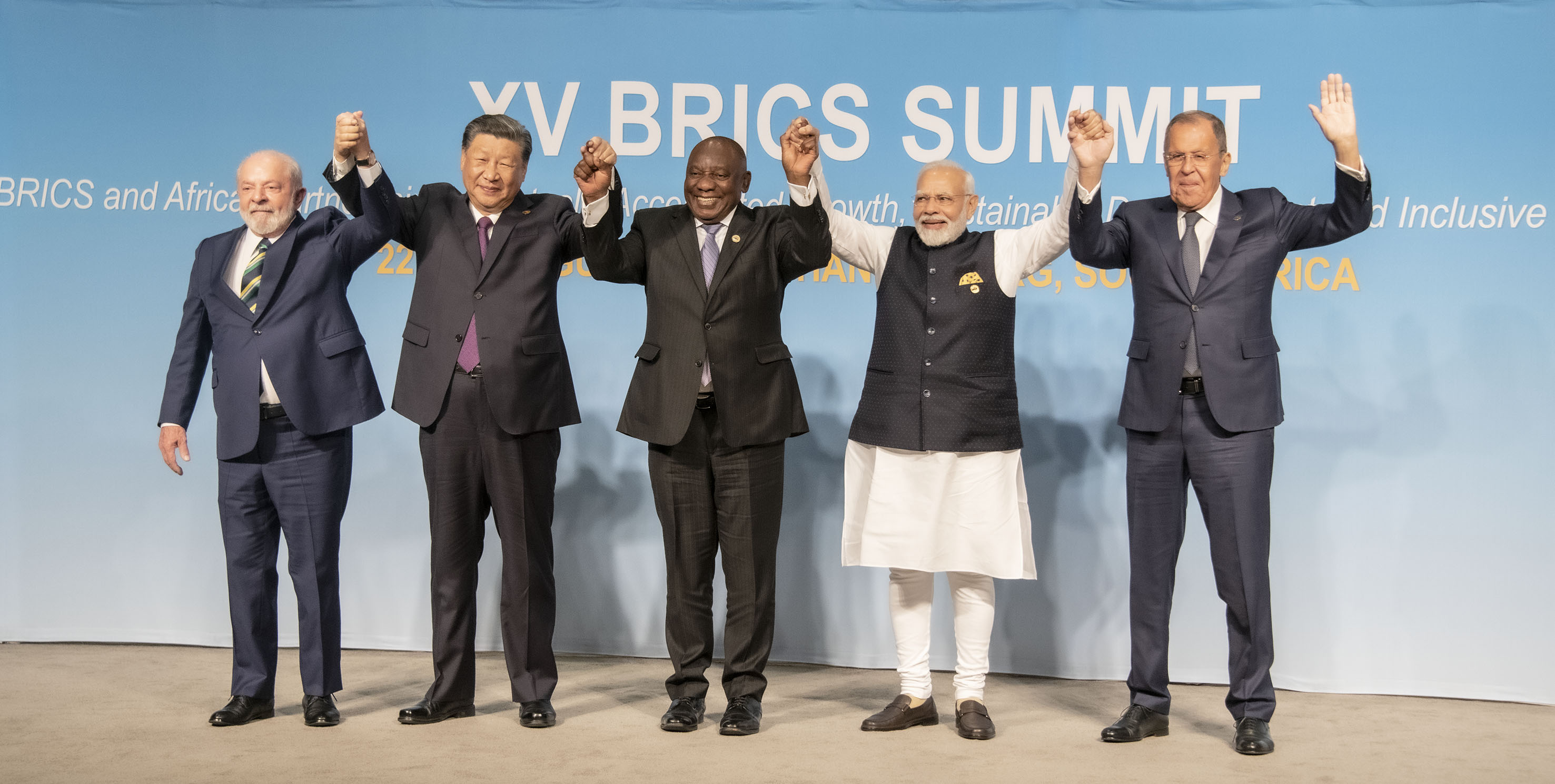
BRICS rises
by Manoj Joshi
Now with 11 members, BRICS’ decision-making by consensus will be that much more difficultOnce upon a time, the BRICS were nothing but a slogan devised by Goldman Sachs’ economists to describe four emerging market economies to which South Africa was later added. But more than a decade later, the grouping, now with an investment bank—New Development Bank—of its own is besieged by dozens of countries of the Global South for membership.The Johannesburg summit of BRICS has drawn unusual interest around the world. There was a time when it barely merited a mention in the western press, but now it has been the subject of major stories, in which some saw BRICS as brittle whiel others thought it was seeking to challenge the G7 and the western world through a process of enlargement. While the BRICS puts itself forward as a unified face of the emerging economic powers, the reality is that within the organisation—which is neither a trade nor military bloc—there is considerable jostling between two Asian powers who are developing a global imprint—India and China.BRICS expansion announced in JohannesburgOne of the issues where this jostling played out in was the BRICS expansion process. Reportedly, 40 countries have expressed interest in joining BRICS, though some 22 nations had formally expressed interest in joining the bloc. With the latest expansion, Iran, Egypt, Argentina, Ethiopia, Saudi Arabia and UAE have been offered membership effective 1 January 2024. That there was a bit of lobbying is evident from the fact that last week, President Ebrahim Raisi of Iran spoke on the phone with Prime Minister Modi. According to the official spokesman, they talked about “regional and bilateral matters” as well as issues like the expansion of BRICS. The two leaders later met in Johannesburg as well.There was some doubt at the beginning of the summit as to whether expansion would actually be announced. This was because of the intense negotiations over the names of the proposed members.Earlier this month, an Indian official spokesman had clarified that India believed that BRICS expansion should take place through “full consultation and consensus” among members of the bloc. In his speech at the summit, the Prime Minister made it clear that “India fully supports the expansion of the BRICS membership. And welcomes moving forward with consensus in this.” On Thursday, too, there were reports that there were “eleventh hour negotiations” over the potential new members. Reuters claimed that an agreement had meant to be adopted on Wednesday, but it was delayed by India’s introduction of new criteria for membership. On Tuesday President Lula of Brazil had made it clear that his country was did not want to be any kind of “a counterpoint to G7, G20 or the United States. We just want to organise ourselves.”In an organisation that acts through consensus, getting in is difficult, but global politics is about give and take and a certain degree of persuasion and arm twisting does go on. So does the notion of giving a push to countries who you see eye to eye with and blocking countries that you don’t. Sometimes the negotiation involves two powerful players splitting the difference and negotiating the entry of countries in such a way that a balance of sorts is maintained. This is the way India became a member of the Shanghai Cooperation Organisation dominated by China. India’s case was pushed by Russia to balance China, and Beijing finally agreed to have India, if Pakistan, its “iron” friend, could become a member at the same time.Another element in such organisations is that countries seek membership not just to further their interests but to block the ambitions of others. In this way, China sought and became a member of the Asia Pacific Economic Cooperation (APEC) arrangement and once in there, it has used its vote to block efforts by the United States (US) to shape APEC into an Asia Pacific Economic Community in the manner of the European Economic Community that finally gave rise to the European Union.India has been reportedly joined by Brazil in resisting the haste and suggesting that new members may first be given the status of observers. The Indian position has been that while it was all for expansion, there was need to develop and standardise mechanisms to consider the applications and move on them.As of now, BRICS is more of a symbol than a unified and purposive entity. True, it has members like China and India who wield substantial power in their respective regions, but the entity itself hardly functions as an economic bloc of any kind. It does have the New Development Bank headquartered in Shanghai, which, in 2021, sharply stepped up its disbursements to US$7.6 billion, with its total disbursements being of the order of US$32 billion for infrastructure and sustainable development in four continents . The initial subscribed capital of the bank is equally distributed among the BRICS members.China’s role in and vision for BRICSBeijing, no doubt views BRICS as a means of offsetting US global power. In a page 2 commentary in the People’s Daily by someone with the nom de plume “Huanyu Ping,” said that currently the world governance system was “at a historical turning point”. The growth of the emerging market and developing countries has enhanced their influence. But the western-dominated global order was a “stumbling block to world economic development and social progress.” The multilateralist BRICS was therefore providing a model for decisions to be made on the basis of equality and consensus, as testified by the share-holding of the New Development Bank. They also actively promoted reform of the global governance system and upheld the validity of multilateral and multipolar solutions.There should be no doubt about the weightage China has within BRICS. It has a GDP more than twice the size of the other members combined. Its economy may have slowed down but it is still growing, with IMF predicting a 5.2 per cent growth as against 5.9 for India. The others are growing at less than 1 per cent. It has played a significant role in getting together two of the new incoming members, Saudi Arabia and Iran. In 2022, China was the largest trading partner of South Africa, India and Brazil.There should be little doubt that China sees Africa as a battleground in the global struggle against the US. In a meeting with President Cyril Ramaphosa on Tuesday, President Xi spoke of the urgent need for China to promote cooperation with Africa because of “changes and chaos” in the world, an indirect allusion to the US. He took up the theme in the Business Forum meeting that he did not attend, but where his speech was read out: “Right now, changes in the world, in our times, and in history are unfolding in ways like never before, bringing human society to a critical juncture.”China may swear by multilateralism, but it is not really comfortable with it. What it is seeking to do is to shape institutions like BRICS in its own image for countering its principal rival, the United States of America. In this, it is unlikely to get Indian support, so what it is trying to do is to pack its membership with countries where it has already made significant investments through its Belt & Road Initiative. Such countries would be inclined to follow its global agenda, which is now manifesting itself as the Global Security Initiative, Global Development Initiative and the Global Civilisation Initiative.The Chinese aim, according to James Kynge in the Financial Times is two-fold. The first is to ensure that large parts of the world remain open to Chinese investment and trade in an environment where western attitudes are increasingly hardening. And the second is to have a bloc of votes in multilateral forums like the United Nations (UN) to project Chinese influence.In the turbulent world, China’s path is not an easy one. Its economy is slowing down and its global security calculations have been roiled by the Russian adventure in Ukraine. Further, in promoting the Global South it runs up against India which has its own ambitions, as well as the backing of the west. Even while promoting the UN and its institutions, China is not interested in any serious reform there because that could result in a bigger role for its adversaries like Japan and India.Done increases with the expansion of its membership. Now, with 11 members, things will be that much more difficult. The BRICS countries have economies and geopolitical profiles that are hugely divergent, and which makes consensus-based decision-making hugely difficult.









